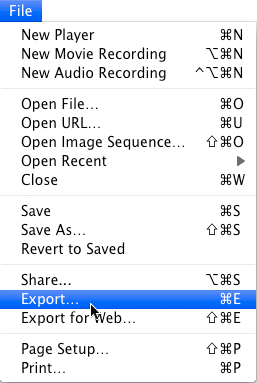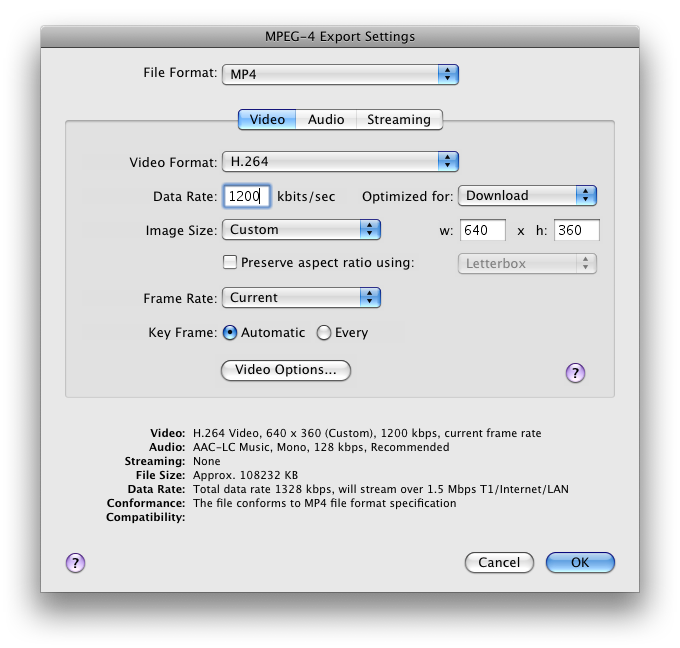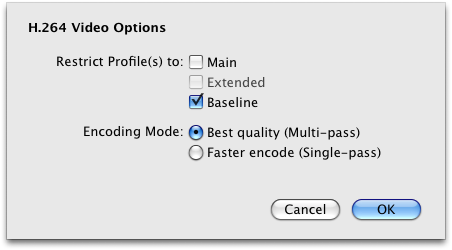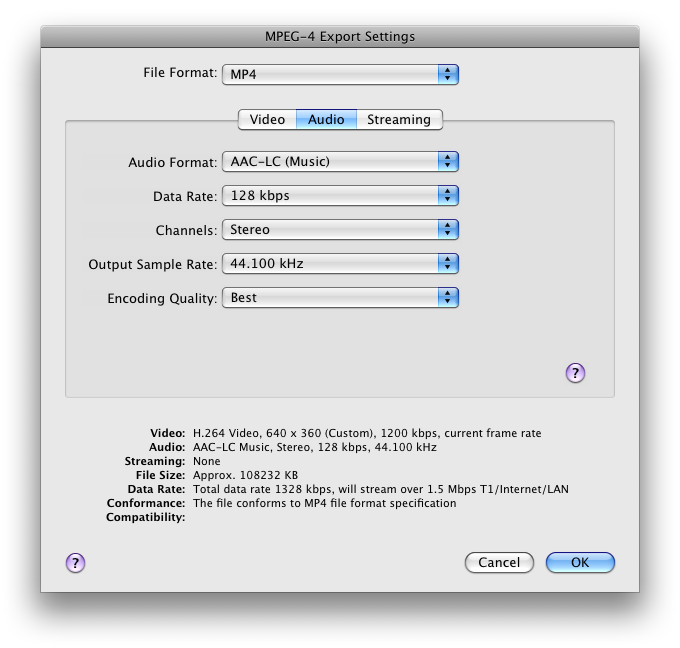Nearly a week after it was first released, the Clam Dip episode of my podcast is finally playable on the iPhone. Here’s how I did it using QuickTime Pro, starting with a 16:9 NTSC DV source file:
- Open the source file in QuickTime Player.
- From the File menu, choose Export. You must have QuickTime Pro registered on your computer for this function to be available, however if you don’t have QuickTime Pro, these settings should work on any other application that lets you export QuickTime files and gives you access to all of the necessary settings.

- At the bottom of the dialog box, choose Movie to MPEG-4 in the Export field.

- Click the Options button.
- Use the following settings for the Video tab:
File Format: MP4
Video Format: H.264
Data Rate: 1200 kbits/sec. This is a suggested bitrate. To be playable on the iPhone, the combined audio/video bitrate must be at or under 1500 kb/sec. Depending on your audio, you may want to use a lower video bitrate.
Image Size: 640 x 360. This is the maximum widescreen resolution supported by the iPhone. If you’re using a 4:3 video, you can bump it up to 640 x 480. Thanks to Jesse Hollington of iLounge for the info in this article.
Frame Rate: Current
Key Frame: Automatic
- Click the Video Options button.
- In the Video Options window, restrict the profile to Baseline. This is the only profile the iPhone will play. Missing this setting prevented several versions of my video from playing on my iPhone until I figured out how to access this setting from this post by Neil Ghoshal in the Apple Discussions group.

- These are the settings I used for the Audio tab; but you can probably get away with doing just about anything here as long as you don’t exceed 1500 kb/sec for the final file.
Audio Format: AAC
Data Rate: 128 kbps
Channels: Stereo
Output Sample Rate: 44.1 kHz
Encoding Quality: Best
- After exporting the file with all the settings above, the final thing I did was import the file into iTunes and add artwork and other meta data by selecting the video and choosing Get Info from the File menu. You can easily find the modified file by choosing Show in Finder from the File menu.
Phew, I’m glad I finally got that sorted out. Optimizing for a specific device sure makes things complicated. It would be nice if I could add some higher resolution versions for other viewers, but as far as I know there’s no way to use multiple versions in the same feed, and I don’t want to manage multiple feeds for HD, iPhone, etc. Maybe someday this won’t be an issue.
I would have just gone with QuickTime’s iPhone preset for all this, but when I tried that it wasn’t understanding either the anamorphic tag or the non-square pixels of DV (or both), and ended up looking distorted. The iPhone itself I know does not support non-square pixels. Maybe I should have tried exporting from iMovie; but I am just realizing that now as I write this. If anyone has tried this, please post away in the comments below. Non-square pixels is something I’m used to, as when I did lots of video work most of my source material was 720 x 480 4:3 DV and the final output was 720 x 480 4:3 MPEG-2 on DVD. Now my source is 16:9 DV or HDV.
As I ramble on here, I’m reminded that video is always a technical challenge. Besides compression and resolution issues, I think by far the worst development to ever enter the field,* which we’ve had the chance to eliminate with every digital format, but haven’t, is interlacing. I don’t know why it was ever included in the HD standard. If I was in charge, I would have said, “We may not be able to make affordable 1080p devices in the current timeframe, but you know what, SD has gotten us this far; let’s just push things back a few years and make the ATSC HD standard as 1080p.” But whatever. Maybe I’m just bitter because I used to do jobs which included converting PowerPoint slides to video. When PowerPoint slides aren’t created by video geeks (and very few are), the video editor (me) gets hit both by resolution and interlacing issues. If the DVD is going to be displayed on a CRT TV, you lose 50% of your original resolution if the PowerPoint slides were created for a 1024 x 768 monitor and you want all that text around the edges to fit within the title-safe area. Quite a stark difference in screen real estate. Interlacing shows its ugly self via the flicker effect on tiny serif text. And don’t even get me started on trying to get the color and luminance on those slides to be broadcast legal.
At least I never worked in print. They have to deal with stuff like DPI and CMYK. I have trouble collating.
* Get it? Field. Interlacing. Never mind.
you can also use iMovie 08
Thanks, Ted. I’ll probably try using iMovie for the entire process with the next couple of episodes as I’ll soon be away from my desktop (which has Final Cut) for two weeks. I’ll also try editing in HDV so I have a better master. I’ll let you know how it goes.